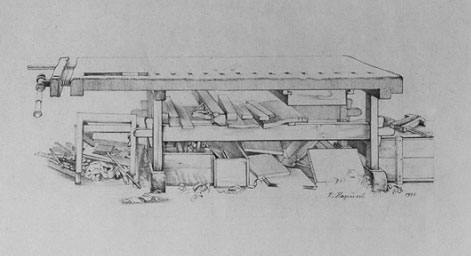We may receive a commission when you use our affiliate links. However, this does not impact our recommendations.
I’ve collected tons of drawings of old workbenches, during the years, and most fall into two categories:
1. A typical workbench with typical vises that looks like lots of other workbenches.
2. Workbenches that were drawn by an artist that have vises that would never work and that are put in stupid places where vises never should be. Oh, and usually the workbench joinery is all messed up, too.
Today I have to add a third category: A 1943 German workbench that could be the result of artistic license or could be a really good idea.
This image was dug up by Jeff Burks, a fellow woodworking historian who knows my love of all things relating to benches. The structure of the bench is pretty standard German/Scandinavian fare: A trestle base with big sled feet. Plus square dog holes – one of which is unfortunately placed right over the base of the bench.
What is very interesting about this bench is the combination vise on the left end of the bench. Using one bench screw, the vise has a chop like a face vise on the end of the bench. And the same screw drives a wagon vise for pinching your work between dogs.
This is a very non-traditional way to do things. Typically the face vise goes on the front face of the bench, and the wagon vise goes on the right side of the bench.
However, I think this bench could actually work – if you had a big enough shop so you could saw while standing on the end of the workbench.
This vise has some obvious disadvantages:
1. You have only one screw. So you can’t clamp something in the face vise and simultaneously work between dogs.
2. You’ll need a fairly long screw to get enough travel in the wagon vise and make it through the thick jaw of the bench.
3. You would be planing into the vise mechanism, which is generally a no-no. In theory, it would wear out the vise a little faster – though it’s probably not much an issue.
Next time I’m in Germany (in June), I’ll have to show this drawing to the students and see if any of them have ever seen one of these in the wild.
— Christopher Schwarz
Interested in choosing the right vise for your work? I cover this topic exhaustively in my first book “Workbenches: From Design & Theory to Construction and Use.” It’s available through most book sellers and through ShopWoodworking.
Here are some supplies and tools we find essential in our everyday work around the shop. We may receive a commission from sales referred by our links; however, we have carefully selected these products for their usefulness and quality.









My part of Europe is under heavy German influence when it comes to woodworking and some time ago I discussed workbenches with my grandfather who is a retired carpenter. He said that there were two types of work benches around in the 50s when he was learning the craft. One type was a typical German style bench which was used by carpenters and which he used, and still owns, and than there was the one used by wheel makers.. Since they used draw knives to round up square stock for wheel spokes they mainly used dogs for clamping the stock, that sort of a bench did not have a face vise, only a wagon vice. I am yet to see one in person, but from the description this might be it. I will show this to my grandfather to see what he makes of it..
I have seen a lot of workbenches around, both in use and for sale, and all of them were well known traditional German style, wheel makers benches obviously were quite obscure, so it might be possible that they are quite rare in books as well, I suppose.
What keeps drawing my eye is the guide rail that stands in place of the other screw on that end vice. I KNOW I would get in a hurry and wind up inadvertently opening a handy access hole to my lower intestine on that thing. OSHA would have a field day with this bench!
“if you had a big enough shop so you could saw while standing on the end of the workbench.”
Chris, are you picturing a western-style saw rather than a stand-up-and-use frame-saw?
Paul
I’m curious about the two boards near the center of the shelf that look warped. Is that a misrepresentation in the drawing, or is there a reason for the boards not to be flat?
I’d vote for it being a left handers bench. The artist probably was not trying to produce a scaleable plan of the bench so things like a misplaced dog hole, or lack of a dog in the wagon vise block are not a big deal. It does look a lot like my bench in the middle of a project – except the top is a lot cleaner.
The negative isn’t flipped – notice the signature in the lower right hand corner. I think it’s artistic license combined with happy accident. It’s an elegant idea that would work well. I used to have a small Garrett Wade bench with only an end vice with two dog holes in it, and I used it just this way – as both a regular vise and as a “wagon” vise for planing. Yeah, it racked a little but the world didn’t end or anything.
“2. You’ll need a fairly only screw to get enough travel in the wagon vise and make it through the thick jaw of the bench.”
What is a “fairly only screw” and where do you get one?
The lower half of the bench with all the stuff looks just like mine. I am half German maybe I can say its artistic.
If indeed this is a left-handed bench I’m curious if left-handed, fenced planes were available other than to a craftsman who made his own, or did they have to do as I do and switch to planing into the vice when using a fenced plane? Until Veritas introduced their left-handed small plow plane I had never seen a plane specifically designed to be used left-handed that utilized a fence, either fixed or adjustable. By necessity I am ambidextrous but I think I’m better and faster when working left-handed.
Just a thought, the screw appears to be metallic. There was a time that machined iron/steel was very expensive. This design would save the cost of a screw. And if the traveling block is attached to the end of the screw, no it would not have to be much longer than usual.
Another possibility is a flipped printing. The artist may not have flipped the drawing when they were cutting the original printing plate. It’s pretty common with photos. Like the billy the kid, the photo looks like he’s left handed until you look at the guns and see they are backwards. I bet it’s just another. Artists screw up. How often do you find left handed benches? Let alone in drawings.
Very cool drawing. I like the idea about it being a left handed bench, being a lefty myself. The vise is really out of the way for surface planing, but it is so out of the way in fact, that I wonder where you do your jointing?
Still love the drawing.
Andrew
Chris,
Could it be designed for a left-hand woodworker? He could stand at the left end of the bench and use the end vise as a front vise. It looks like there is space there to stand.
He could plane with his left hip toward the bench. He could open the drawer on the right side with his right hand and reach for tools with his left hand, just the opposite of what most right-handers would do.
It looks like there is a dog hole in the vise chop, but nothing in the traveler of the wagon vise mechanism that could be used to secure a board.
Rob